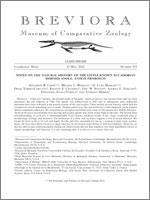Until very recently, the horned anole of Ecuador, Anolis proboscis, was known from only six male specimens, the last collected in 1966. The species was rediscovered in 2005 and in subsequent years additional specimens have been collected in the general vicinity of the type locality. These include several females, which lack the conspicuous rostral appendage seen in males. Despite rediscovery, the natural history of this enigmatic anole remains almost completely unknown. We conducted an ecological and behavioral study of this species near Mindo, Ecuador. Anolis proboscis is an extremely slow-moving and cryptic species that often occurs high in the trees. The rostral horn notwithstanding, A. proboscis is indistinguishable from Greater Antillean anoles of the “twig” ecomorph class in morphology, ecology, and behavior. The possession of a horn only by males suggests a role in sexual selection. We found the horn in life to be soft and highly flexible and thus unsuitable for use as a weapon in male–male combat; hence, the horn most likely serves as a signal and may be involved in mate choice or territorial displays. However, we did not observe any social encounters during our observations and are thus unable to test these hypotheses. Given its cryptic morphology and behavior, it is not surprising that A. proboscis is so rarely observed.
How to translate text using browser tools
31 May 2012
Notes on the Natural History of the Little-Known Ecuadorian Horned Anole, Anolis proboscis
Jonathan B. Losos,
Melissa L. Woolley,
D. Luke Mahler,
Omar Torres-Carvajal,
Kristen E. Crandell,
Eric W. Schaad,
Andrea E. Narváez,
Fernando Ayala-Varela,
Anthony Herrel
ACCESS THE FULL ARTICLE





